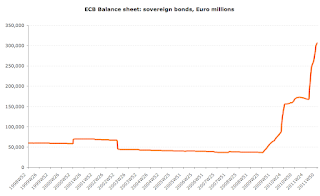As the annus horribilis concludes for the terminally
ill, but refused (by the ECB & EU & the respective Governments) death,
Euro area banks, the key note of that Mahlerian (the 5th
symphony-styled) Trauermarsch is the LTRO allocation of cheap 3 year €489
billion worth of ECB credit (at 1%) to the European banks. And, thus, the theme
for 2012, the second movement in the opus magnum of the Euro destruction, is
the looming recapitalization deadline for the said zombies – the end of June.
Alas, the hope that seems to sweep the markets to
boost, albeit moderately, Euro area banks valuations – the hope that having the
mother of all carry trades can help these banks recover their margins just in
time to use ‘organic’ recapitalization path through mid 2012 – is seemingly out
of reach.
Firstly, I put ‘organic’ in the inverted commas, since
the margins rebuilding on the back of ECB-created artificial liquidity boost is
about as organic as performing a puppet show with a corpse is ‘live-like’.
Secondly, the carry trade I am talking about - for
those readers of this blog who are unfamiliar with finance – is the artificial
exercise of taking cheap loans in one country/currency and carrying funds into
purchase of assets in another country/currency. Of course, with nothing but
loss making (or near-loss making) assets in the markets of the Euro zone, any
banks who borrowed funds in the LTRO will be either buying Government paper
(yielding on average, say, 3.0 percent margin on borrowings gives Euro area
banks pre-tax uplift of just €7.3 billion in 6 months time (and no, there are
no capital gains realizable, since buying today and selling into mid-2012 will
leave this paper, at best, capital gains neutral). Thus, to make even a dent in
the capital demand, the banks will be needing assets yielding more than double
the junkier Euro area sovereign yields, which means carry trade, and all
associated currency and asset risks.
Of course, Euro area banks can try to magnify their
returns via ECB-offered leveraged carry trades. But unless ECB offers more LTRO-styled longer term operations, doing so at 3mo or even 11mo liquidity supply windows would be simply mad.
So, having borrowed through LTRO, Euro area banks will purchase Government
bonds which then can be used as a collateral for further ECB borrowing. So let
us assume that the banks will be buying liquid debt, e.g. Spanish or Italian.
The margin earned by banks is ca 2.6-3.5% per annum after they cover the cost
of LTRO borrowing. Note, this carry trade will turn loss-making for the bank if
the sovereign bonds yields fall below 1% cost of ECB LTRO funds. In my view,
this is highly unlikely.
So the whole operation can provide some €14.6 billion
annually to the banks in terms of profits earned. And this is pretty much the
unleveraged maximum. Nice one, but through June 2012 hardly enough to support
banks recaps. Even if EBA deadline is shifted to December 2012, profits from
LTRO are nowhere near the required funds to cover recapitalizations. Recall
that under 9% Core Tier 1 scenario, euro area banks require something to the
tune of €119 billion in fresh capital.
The downside
from this conclusion is that the Euro area banks will require, post LTRO either
a warrant to die (the preferred option, assuming the death warrant involves
orderly shutdown of the insolvent banks) or a public bailout of immense
proportion. Given the EU hit some serious trouble coming up with €200 billion
for loans to IMF, good luck with that latter option.





























